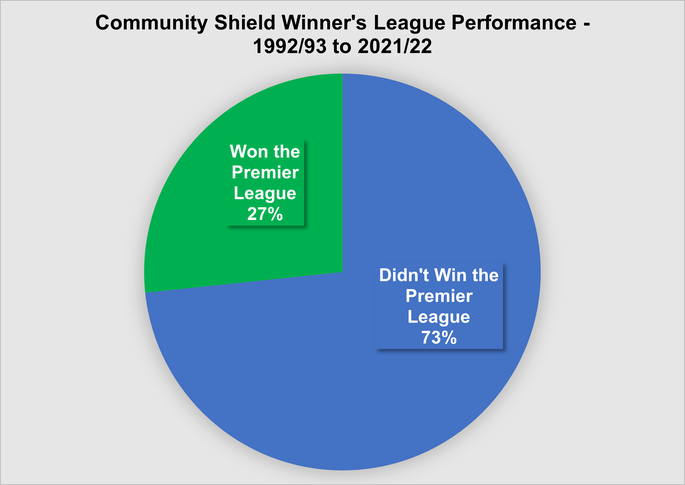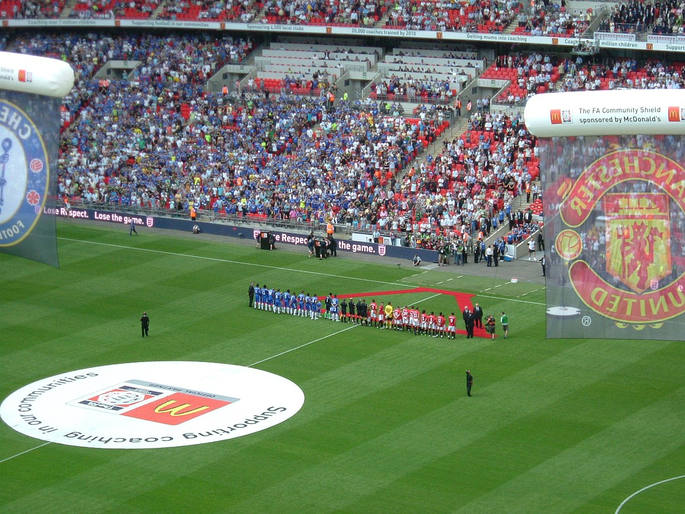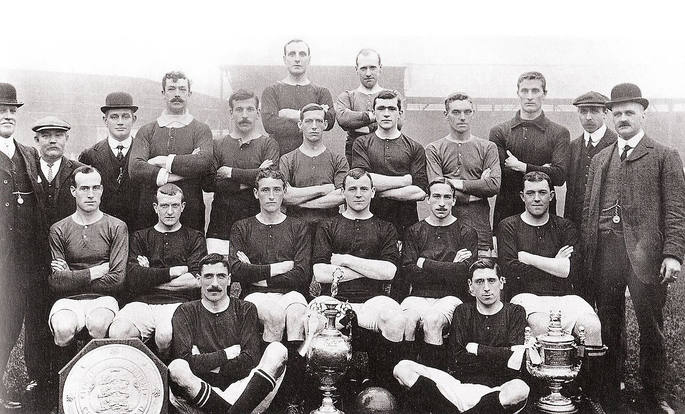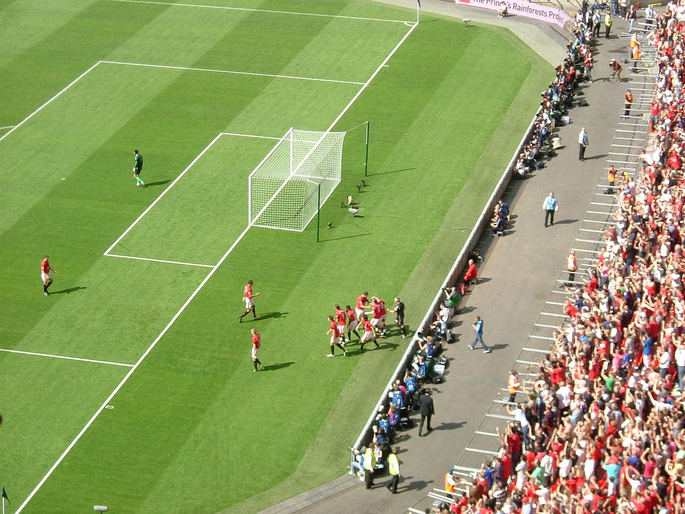Fast Facts
- When: 6th August 2023
- Where: Wembley Stadium, London
- Watch: ITV
- Official Website: The FA Community Shield
The FA Community Shield is the traditional curtain raiser for the new football season in England. The game see’s the reigning Premier League champions take on the current holders of the FA Cup. If a team wins both the Premier League and the FA Cup in the same season, the match will be played between the top two teams in the previous season’s Premier League.
The match is played at Wembley Stadium, traditionally a week prior to the Premier League season kicking off. Although technically a friendly game, both sides look for a moral boosting victory at the national stadium ahead of the new campaign.
Manchester United have the most Community Shield victories with 21 wins or shared games from 30 appearances. They are ahead of Arsenal and Liverpool with 16 Community Shields. Manchester United and Chelsea share the most Community Shield defeats with 9 each.
Below we will have all the best offers and tips on the game when they become available, as well as some background stats and facts surrounding the competition.
Existing Customer Free Bets & Money Back Offers
Please Note: This event has now ended.
Event Stats
Community Shield Results – 2010 to 2023
| Year | Winner | Runner-Up | Score |
|---|---|---|---|
| 2023 | Arsenal | Manchester City | 1-1 (4-1 on pens) |
| 2022 | Liverpool | Manchester City | 3-1 |
| 2021 | Leicester City | Manchester City | 1-0 |
| 2020 | Arsenal | Liverpool | 1-1 (5-4 on pens) |
| 2019 | Manchester City | Liverpool | 1-1 (5-4 on pens) |
| 2018 | Manchester City | Chelsea | 2-0 |
| 2017 | Arsenal | Chelsea | 1-1 (4-1 on pens) |
| 2016 | Manchester United | Leicester City | 2-1 |
| 2015 | Arsenal | Cheslea | 1-0 |
| 2014 | Arsenal | Manchester City | 3-0 |
| 2013 | Manchester United | Wigan Athletic | 2-0 |
| 2012 | Manchester City | Chelsea | 3-2 |
| 2011 | Manchester United | Manchester City | 3-2 |
| 2010 | Manchester United | Chelsea | 3-1 |
About The Community Shield
When it comes to top-flight British football, the majority of trophies that are played for are full of meaning and considered to be worthy of celebration. The biggest exception to that rule comes in the form of the Community Shield, which is considered by many to be a friendly game that kick-starts the football season.
The competition was founded in 1908 as the Football Association Charity Shield and saw the champions of the Football League First Division play against the Southern League champions. Over the years the format of the competition has changed numerous times, as you’ll discover, with the match nowadays seeing the Premier League champions taking on the winners of the FA Cup; that is unless the champions did the double, in which case they’ll play the runners-up in the league.
The competition now known by the moniker of the Community Shield grew out of a tournament known as the Sheriff of London Charity Shield. That match saw the best professional side go up against the best amateur team, with the professional side usually being either the top-flight or the FA Cup winners. More often than not the amateur side would be Corinthian, who were one of the most respected amateur teams at the time.
The tournament earned its name on account of the fact that a shield was offered to the winner of the match by the then Sheriff of London, Sir Thomas Dewar. The money earned from the match was distributed to charities and local hospitals, hence being called the Sheriff of London Charity Shield. It lasted for nine years until it was felt that the professional game was too dominant. This in turn saw the creation of the Amateur Football Association in a split from the Football Association, thereby ending the cordial arrangement between the two sides of football.
The Community Shield Is Born, 1908
As is so often the case with major sporting events, the fact that the competition as it was came to an end didn’t mean that the entire enterprise was shelved. Instead, a replacement competition was desired and that came in the form of the Football Association Charity Shield. Now, instead of the best professional and amateur teams going head-to-head, the tournament saw the champions of the Football League First Division take on the winners of the Southern League.
The Southern League wasn’t the same as it is nowadays, made up of mostly semi-professional clubs. Instead, it was quite literally a league for clubs based in the South of England, with Northern clubs having developed much quicker than their counterparts from further down the coast. For a time it was considered to be secondary competition to the Football League, with two sides that played their football within it in the from of Southampton and Tottenham Hotspur making it to the FA Cup final at the start of the twentieth century. Spurs went on to win it, being the only club from outside the top two divisions of English football at the time to win the trophy.
The first match in the tournament’s new guise took place in 1908 when Manchester United played against Queens Park Rangers and required a replay to beat them. With the first match having ended in a 1-1 draw, the Red Devils won 4-0 in the replay. Both matches took place at Stamford Bridge, the home of Chelsea Football Club, and the first iteration of the tournament is the only one to have gone to a replay.
The Fixture’s Shifting Format

In 1913 it was decided to reignite the idea of the competition being a match between the best amateur and professional sides in the game, though this didn’t last long because of the suspension of footballing activity when the First World War broke out. In 1921 the competition took on the same format that is used nowadays when the winners of the FA Cup and the First Division went up against each other for the first time.
It took a while for the competition’s format to settle down and numerous different versions were tried throughout the 1920s. In 1927 the same format as during the days of the Sheriff of London Charity Shield days was used when the winners of the FA Cup, Cardiff City, and Corinthians played in the match.
First Division Winners vs FA Cup Winners, 1930
It was in 1930 when the format that we understand today was reintroduced when the Football League First Division winners played against the FA Cup winners. That particular format has remained in place pretty much ever since, with a few exceptions.
The 1950 version of the competition saw the England World Cup team play against an FA team that had been touring Canada that summer
When Tottenham Hotspur won the First Division and FA Cup in the same season, becoming the first team to do so in the twentieth century, they played against a Football Association XI
It wasn’t until 1959 that the modern method of having the Charity Shield take place at the start of the season began. There was, however, still a debate around what should happen if a team won both the league and FA Cup, with Arsenal doing just that in 1971. Interestingly, the pre-season games that the Gunners had arranged meant that they couldn’t play in the final anyway, so Leicester City were invited as the winners of the Second Division to play against the FA Cup runners-up, Liverpool.
Whilst the format might have been settled on, the teams that won the First Division and FA Cup weren’t always that bothered about taking part in the glorified friendly. Leicester City might have been the first club to win neither the FA Cup nor the First Division to lift the trophy in 1971 but they weren’t the last. The following year neither the First Division champions Derby County nor the FA Cup winners Leeds United wanted to play in the match, so the team that finished fourth in the First Division, Manchester City, and the winners of the Third Division, Aston Villa, went up against each other.
The Move to Wembley, 1974
In 1974 the Secretary of the Football Association, Ted Croker, made the current format the official format of the competition. He made the decision to move the final to Wembley and made it a requirement for the winners of the top-flight and the winners of the FA Cup to take part in the match. Interestingly, the match was drawn four times in the 1980s and 1990s but, rather than replay the game as had happened in 1908, the two teams shared the trophy for six months each.
Charity Status Lost, 2002
When the First Division split away from the rest of the Football League and became the Premier League in 1992, the Charity Shield became something of a showcase event between the winners of the new-look top-flight and the FA Cup victors. It was seen as an indicator of the campaign ahead, taken slightly more seriously by both teams involved.
It maintained the name of the Charity Shield until the Charity Commission declared in 2002 that the Football Association was failing to live up to its obligation of specifying where the money from ticket sales was going, as well as not paying the charities quickly enough. The result of these findings was that the competition had to be renamed, taking on the moniker of the Community Shield. It was played under this title for the first time in 2002 when the defending Premier League champions Arsenal defeated the FA Cup winners Liverpool 1-0.
In an interesting twist in events, the FA’s official silversmith, Thomas Lyte, rebuilt and restored the original Charity Shield from 1908 in 2016 and auctioned it off. It sold for £40,000 and the money was donated to the Bobby Moore Fund for Cancer Research UK, with the Bobby Moore Fund becoming the FA’s official charity as a result.
Current Format
When it comes to the format of the Community Shield, there isn’t a lot to tell you. There is no qualification for the game more complex than being the team that won either the Premier League or the FA Cup at the end of the previous season. The only exception to that comes in the form of the team that finished second in the Premier League being the opposition to the champions should the side that won the top-flight also win the FA Cup.
The one thing that is noteworthy are the rules of the competition, which are essentially the same as for a Premier League game. There are eleven starting players in each team as well as seven substitutions. The big difference between them is that teams are allowed to make six subs during the match, rather than the usual three. If the match is level at full-time then the game goes straight to a penalty shootout without the need for extra-time.
The ‘Curse’ Of The Shield
It is true that football teams used to take the Shield more seriously in the past, before the constant and never-ending commitments of pre-season tours and the relentlessness of games meant that it became an afterthought. Nevertheless, footballers are a suspicious and superstitious type, so it’s little wonder that many believe in the ‘curse’ of the Community Shield.

Between the formation of the Premier League and 2020, just 8 of the 28 winners of the trophy went on to win the top-flight in the season that they were victorious. Correlation doesn’t always equal causation, of course, but it’s interesting to note that Arsenal won 7 Community Shields under Arsene Wenger and lifted just three FA Cups during the same period. When David Moyes won the Charity Shield as Manchester United manager he might have hoped that it would be the start of a glorious period as Alex Ferguson’s successor, only for him to be sacked before the end of the season.
The Shield’s Status in the Modern Game
Whilst the Community Shield is unquestionably one of just four domestic honours that can be won by teams in the English top-flight alongside the Premier League, FA Cup and EFL Cup, it is not considered to be a major honour in the same way that the other three are. As a result, teams don’t take it quite as seriously as they might do one of the more prestigious trophies, with Manchester United’s former manager Alex Ferguson once saying that he used it as a ‘barometer of fitness’ of his players.
On the flip side of that opinion, however, is the one that declares it be a trophy of some importance. After all, it is the first trophy of the season and can give players a confidence boost before the domestic campaign gets underway. The Chelsea manager at the time, Antonio Conte, declared in 2017, “It is not a friendly game. It is an official game and there is a trophy so for us it must be important”. Managers and players can take it as seriously as they like, of course, but supporters and members of the media will never see it as anything other than a friendly match. That’s why it’s never counted amongst the major silverware of serious teams when they look to see how successful they’ve been.
Hosting the Community Shield
Between 1974 and 2000 the competition took place at Wembley, moving to the Millennium Stadium in Cardiff when the old Wembley was knocked down in 2001. It remained there until 2007 when the current Wembley Stadium opened its doors and it has been played there ever since. The exceptions to that was in 2012 when Wembley was being used for the Olympic Games and so the match was played at Villa Park. In 2022 the game will take place at Leicester’s King Power Stadium with Wembley hosting the Women’s European Championship.
It might be the case that the tournament is played at Wembley nowadays, but before 1974 it was played out at a host of different football ground. Stamford Bridge, the first location for the competition, was used on ten different occasions between 1908 and 1970, for example. It has also been hosted by eight different grounds including Anfield, Turf Moor and St. James’ Park once. The table below shows the grounds that have been the venue for the Community Shield.
Community Shield Hosts Venues (1908 to 2022)
| Stadium | Games | Stadium | Games | Stadium | Games |
|---|---|---|---|---|---|
| Wembley (Old) | 27 | Wembley (New) | 14 | Stamford Bridge | 10 |
| Highbury | 7 | Millennium Stadium | 6 | Old Trafford | 6 |
| White Hart Lane | 6 | Maine Road | 5 | Villa Park | 3 |
| Goodison Park | 3 | Molineux | 2 | The Den | 2 |
| Filbert Street | 1 | Elland Road | 1 | Anfield | 1 |
| Portman Road | 1 | Turf Moor | 1 | Burnden Park | 1 |
| Roker Park | 1 | St James’ Park | 1 | King Power Stadium | 1 |
Interesting Facts
The Community Shield has been taking place for more than one hundred years, so it’s entirely fair to say that there are plenty of interesting facts surrounding the competition. We’ve already told you about the alleged ‘curse’ that is placed on winners, as well as the various different grounds that have played host to it. Here are some other facts you might like to know:
- Manchester United have won the competition more than any other side, lifting the trophy seventeen times on their own and sharing the honour four more times
- Arsenal are next on the list, having won it fifteen times alone and sharing it once, which is one more than Liverpool have managed (ten outright wins, five shared)
- Chelsea and Newcastle both appeared in the final five times without winning it, with the London club doing so between 2010 and 2018 and the northern side achieving this between 1932 and 1996
- Manchester United’s 8-4 win over Swindon Town in 1911 is the highest scoring final
- Everton won the trophy four times consecutively between 1984 and 1987, sharing their 1986 win with their city rivals Liverpool
- Manchester United have lost the trophy the most consecutive times, doing so on four occasions between 1998 and 2001
- Pat Jennings scored against Manchester United for Tottenham from his own penalty area in the 1967 final
- Brighton & Hove Albion won the Shield without lifting either the FA Cup or First Division



